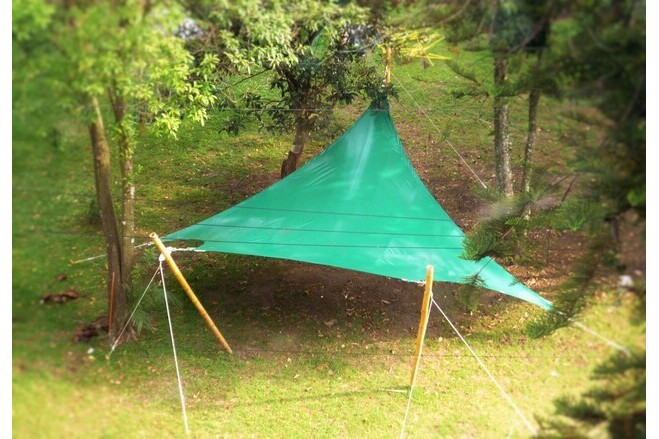Tropical Shelter
General information
-
Location address
Universidad de Costa Rica, Campus Rodrigo Facio, San Pedro Montes de Oca, San José Province
-
Location country
Costa rica
-
Year of construction
2010
-
Year of dismantling
2011
-
Name of the client/building owner
Universidad de Costa Rica
-
Function of building
Shelters
-
Degree of enclosure
Open structure
-
Climatic zone
Tropical - hot and wet all year
-
Number of layers
mono-layer
-
Type of application of the membrane
covering
-
Primary function of the tensile structure
- Rain protection
- Sun protection
Description
The tropical shelter was designed and built during an academic workshop at the University of Costa Rica, introducing a group of architecture students to membrane structures. Students were involved in developing the shelter from an initial design concept through its different design stages, culminating with the fabrication and installation of a real-scale structure. A primary objective was to demonstrate that the climatic behaviour of the tensile structure could enhance favourable thermal comfort conditions. After defining spatial, material, and climatic requirements, the form-finding process was iterated with information obtained from the shading and airflow simulations. The resulting hyperbolic geometry is based on a pentagon with two low points and three high points, upheld by masts of locally harvested bamboo. The membrane was fabricated as a temporary shelter and erected according to the optimum direction of the environmental site analysis. The climate simulations were analyzed and verified on-site, with the results later published in a research article (RevistArquis, 2015. 4(2)).
Description of the environmental conditions
The project was erected on the main University Campus, Rodrigo Facio. The Campus is situated in the metropolitan area of Costa Rica’s central valley at a 3km distance to the capital city San Jose at 1,172m above sea level. San José has an all year tropical wet and dry climate. Precipitation varies considerably between the rainy and dry seasons, with a minimum average rainfall of 6.3mm in January to a maximum of 355.1mm in September. The coolest month is October, with an average temperature of 21.8°C, while the hottest month is April, with 23.7°C. The Campus itself has its own microclimate, showing characteristics of an urban oasis with much cooler temperatures due to abundant vegetation, trees and water streams.
Material of the cover
-
Cable-net/Fabric/Hybrid/Foil
Fabric
-
Material Fabric/Foil
PVC - coated polyester fabric
-
Material coating
PVC-coated polyester
Main dimensions and form
-
Covered surface (m2)
20
-
Form single element
Anticlastic
-
Form entire structure
Anticlastic
Duration of use
-
Temporary or permanent structure
Temporary
-
Design lifespan in years
00-05
Involved companies
-
Architects
Jan-Frederik Flor
-
Engineers
Eurotoldos S.A.
-
Contractors
Eurotoldos S.A.
-
Suppliers
Seaman Corporation
Editor
-
Editor
Jan-Frederik Flor



